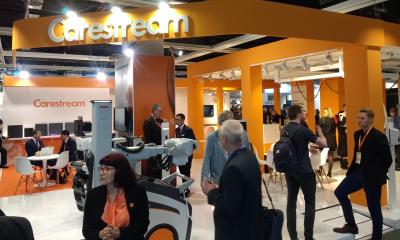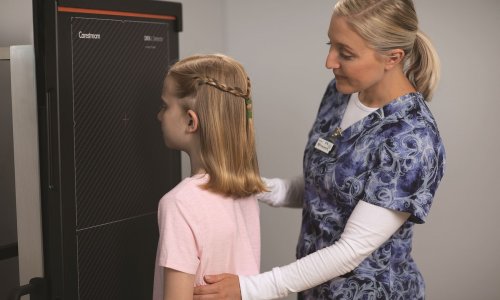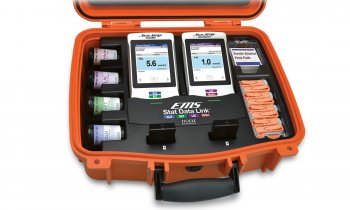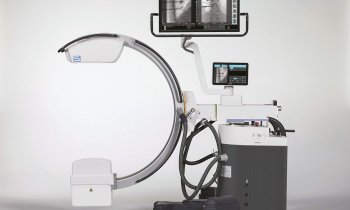Carestream products on show and at work
At the DRK Congress (Deutscher Röntgenkongress, 30 April - 3 May, in Berlin, Carestream Healthcare will introduce its new digital radiography and computed radiography systems, including the DirectView DR 9500 System, the DR 3500 System, as well as its latest single-cassette CR products, DirectView CR Elite and the new Kodak Point-of-Care CR 360.

Also on show will be the company’s IT solutions including enhancements to its RIS/PACS platform, and the latest version of Carestream Information Management Solutions.
Carestream’s rapidly expanding digital mammography portfolio, including computer-aided detection (CAD) software and new CR software that delivers enhanced exchange of information with other vendors’ digital mammography and RIS/PACS systems, was also highlighted. The CarestreamHealth digital mammography portfolio includes multi-modality breast imaging workstations, CR-based mammography systems, computer-aided detection for CR and film-based mammography, special functionality for its RIS/PACS platforms, and laser imagers.
Volker Keller, Carestream Health Regional Market Communication Manager for Europe North, points out many benefits of digital technology, adding: ‘On the clinical side, we see great opportunities for the implementation of healthcare IT systems. Smaller hospitals and clinics will benefit from an all-digital workflow. We have several initiatives underway to provide comprehensive but affordable solutions to the unique challenges of delivering healthcare to rural markets in developing countries.’
Digital mammography and computer-aided detection (CAD) in action
As a centre of excellence for mammography, the Fontana Women’s Hospital in Chur, Switzerland, has a reputation stretching far beyond Swiss borders. Manned by Dr Gerold Reutter MD, the local mammography centre has used Kodak’s digital system from Carestream Health since 2007.
A workstation, including two high resolution monitors, is downstream from the imaging devices: a Kodak DirectView CR 975 Image plate system and a high performance laser Kodak DryView 8900 printer with maximum resolution of 650 dpi.
The monitors display full field digital images of the breast. To demonstrate the CAD system at work, Dr Reutter moved the cursor on the left monitor over several triangular and star shaped symbols. ‘With these tags, the CAD system shows me points of potential interest. The triangles clearly indicate the micro calcifications; the star shaped marks indicate denser soft tissue relative to the surrounding tissue structure. We know there is a high correlation between the preliminary stages of carcinoma and the formation of a micro calcium group of five calcifications/cm2. Such a group is highlighted by the CAD system from Carestream Health and this helps in our diagnoses. The accuracy of findings is very high.’
Dr Reutter mentioned additional advantages in the digital CAD system. ‘Foremost is vastly better image quality. If you compare conventional images with the digital images, you will see what I mean: the differences in contrast, detail and resolution are obvious – the conventional images have a blurred, dull effect.’
Adjusting image brightness and contrast – both not possible with traditional imaging technology, he clicked the mouse to enlarge part of the image marked by the CAD system (the once indispensable magnifying lens is no longer needed). ‘The Carestream CAD system has proved to be of considerable help because it can make valid pre-selections by itself and mark them accordingly. So it is a significant milestone on the road to more reliable breast cancer diagnoses. However, as with all diagnostic benefits,’ Dr Reutter emphasised, ‘the final decision is given by an experienced consulting physician. Leaving an examination to a physician’s assistant is not ethical.’ Staff responsibility at the hospital has not decreased since the CAD introduction. Two observers still carry out the standard assessment procedure, and even the slightest doubt in mammographic findings results in ultrasound confirmation and consultation with other physicians and specialists.
Dr Reutter also described other benefits of digital mammography. The integrated speech recognition system enables direct reporting and automatic conversion into written text. All downloaded, archived image data can be instantly recalled. Hard copy films are no longer stored. Electronic image data also can be printed on films, as well as e-mailed.
‘My experience is that the Carestream CAD system is a significant step forward in the diagnosis of breast cancer,’ Dr Reutter concluded. ‘The digital mammograms clearly outclass traditional images in terms of detail resolution, making our findings more reliable. It is also a well developed system and, through regular updates, keeps pace with changes and remains state-of-the-art technology.’
30.04.2008











